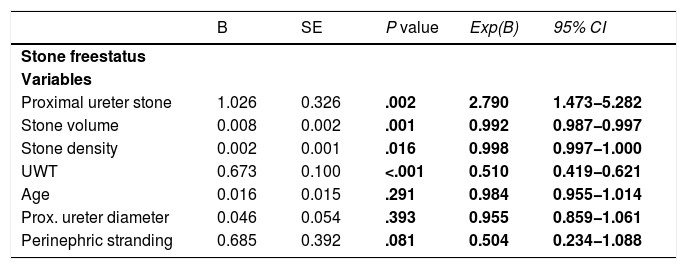To combine non-contrast computerized tomography (NCCT)-based parameters with stone and patient characteristics that are already known to affect shock wave lithotripsy (SWL) success and assess this novel model’s effectiveness in predicting SWL success for single ureteral stones in different locations.
Materials and methodsData of patients treated by SWL for a single ureteral stone between January 2017 and January 2019 were retrospectively reviewed. Demographic parameters of patients and stone characteristics were combined with NCCT-based parameters. NCCT-based parameters included the presence or absence of hydronephrosis, perinephric stranding, periureteral edema, diameter of the proximal ureter, ureteral wall thickness (UWT) at ureteral stone site. The logistic regression method was used for the development of a useful predictive model. Subsequently, the receiver operating curve was used to determine cut-off levels, and a scoring system was developed for prediction of SWL success.
ResultsStone-free rate was 77,1% (267/346) in the entire cohort. Univariate analysis revealed that age, stone volume, density, perinephric stranding, diameter of proximal ureter, and UWT, were associated with SWL success. In multivariate analysis, proximal ureteral stone location, stone volume, density, and UWT were independent predictors of SWL success. The formula used during logistic regression analysis was: 1/[1 + exp {−8.856 + 0.008 (stone volume) + 0.002 (stone density) + 0.673 (UWT) + 1026 (proximal ureteral stone)}]. The scores of 0, 1, 2, 3 and 4 were associated with 97,8%, 83,4%, 60,8%, 33,2% and 11,1% success rates, respectively, in the prediction model based on these parameters.
ConclusionWe conclude that our model can facilitate decision-making for SWL treatment of ureteral stones in different locations.
Incorporar los parámetros basados en la tomografía computarizada sin contraste (TCSC) a las características de los cálculos y de los pacientes comúnmente asociadas con el éxito de la litotricia por ondas de choque (LEOCH) para evaluar la efectividad de este nuevo modelo en la predicción del éxito de LEOCH en cálculos ureterales únicos situados en diferentes localizaciones.
Materiales y métodosSe revisaron retrospectivamente los datos de los pacientes tratados con LEOCH por un único cálculo ureteral entre enero de 2017 y enero de 2019. Los parámetros basados en la TCSC se evaluaron junto con los parámetros demográficos de los pacientes y las características de los cálculos. Los parámetros basados en TCSC incluyeron la presencia o ausencia de hidronefrosis, trabeculación de la grasa perirrenal, edema periureteral, diámetro del uréter proximal, grosor de la pared ureteral (GPU) en el sitio del cálculo ureteral. Se utilizó el método de regresión logística para desarrollar un modelo predictivo útil. Posteriormente, se utilizó la curva ROC para determinar los puntos de corte, y se desarrolló un sistema de puntuación para la predicción del éxito de LEOCH.
ResultadosLa tasa libre de cálculos fue del 77,1% (267/346) en toda la cohorte. El análisis univariante reveló que la edad, el volumen de los cálculos, la densidad, la trabeculación perirrenal, el diámetro del uréter proximal y el GPU se asociaron con el éxito de la LEOCH. En el análisis multivariante, la localización del cálculo ureteral proximal, el volumen del cálculo, la densidad y el GPU fueron predictores independientes del éxito de la LEOCH. La fórmula utilizada en el análisis de regresión logística fue: 1/[1 + exp {−8,856 + 0,008 (volumen del cálculo) + 0,002 (densidad del cálculo) + 0,673 (GPU) + 1026 (cálculo ureteral proximal)}]. Las puntuaciones de 0, 1, 2, 3 y 4 se asociaron con un 97,8%, 83,4%, 60,8%, 33,2% y 11,1% de éxito, respectivamente, en el modelo de predicción basado en estos parámetros.
ConclusiónConcluimos que nuestro modelo puede ser útil en la elección del tratamiento con LEOCH de los cálculos ureterales en diferentes localizaciones.












